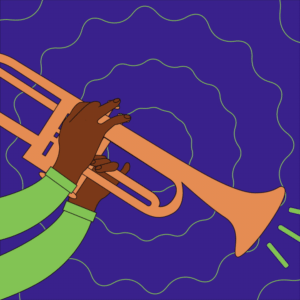A Celebration of African-American Music Month at The FADER is presented by MetroPCS.
This is a story about music, curiosity and tumbling down rabbit holes. It begins (like a lot of my stories do) with Prince. Though Purple Rain drafted me into the Prince army for life, my father never afforded me the luxury of believing that funk or black men wielding guitars started with my man from Minneapolis. The minute I let up on spinning Purple Rain ad infinitum, Dad reached in his vinyl collection for Jimi Hendrix’s Electric Ladyland and Sly and the Family Stone’s Greatest Hits. It always helps to have someone connect the dots with you when it comes to exploring musical connections.
Hendrix died the year I was born. As a latchkey kid with no seatbelt riding in my parents' Pontiac Sunbird enduring the oldies station, I processed their childhood music through osmosis. Goofy rock ’n’ roll novelty hits like “Alley Oop” and “Monster Mash” stuck out, but I learned plenty of Motown and Beatles on those drives, and Hendrix too. Electric Ladyland might’ve been new to me at 13, but “Purple Haze,” “Manic Depression,” “Voodoo Child (Slight Return)” — I was familiar. When Hendrix played N.Y.C.’s Fillmore East recording his Band of Gypsys live album, my pops was there. He knew the guitar god’s middle name was Marshall and blessed me accordingly. I didn’t delve into Are You Experienced or Axis: Bold as Love ’til college, but I hardly thought Prince invented the guitar solo.
Same with Sly Stone. There’s a Riot Goin’ On went number one when I was a baby. But his “Thank You for Talkin’ to Me Africa” was the centerpiece of my favorite homemade high school mixtape because I combed through the album looking for clues to the blueprint of Prince’s funk. That oldies station (WCBS-FM) described Ike Turner’s “Rocket 88” as the first rock ’n’ roll song, and explained all about how the Beach Boys stole Chuck Berry’s “Sweet Little Sixteen” for their “Surfin’ U.S.A.” All that insider-baseball music info nestled in my subconscious somewhere. But the Sly songs stuck — “Hot Fun in the Summertime,” “Everyday People,” “You Can Make It if You Try” and more — enough to send me digging through Stand! and There’s a Riot Goin’ On. At 34, I’d write a book about the album.
So I knew Sly Stone’s male-and-female, black-and-white group set the template for Prince and the Revolution; I knew Prince passed the mic around on “1999” just like the Family Stone. Ironically, locating the past in the present seemed easier in the 1980s than it does right now, with 26 million songs in everybody’s pocket. I recently conversed with a 25-year-old blogger who had no idea who Sheila E is. Granted, the legendary drummer’s hits are over 30 years behind us. But when I was 25, for sure I’d heard of, for instance, Otis Redding or The Temptations. Apple Music, Spotify and Pandora can all lead a horse to water but can’t drum “The Glamorous Life” into you if you’re not interested.
Curiosity is the key. Because when Prince name-dropped Joni Mitchell’s “Help Me” in “The Ballad of Dorothy Parker,” I bought the singer-songwriter’s Court and Spark the next day. (He’d already told Rolling Stone that Mitchell’s The Hissing of Summer Lawns was “the last album I loved all the way through,” and I’d rushed out to buy that too.) When critics compared the psychedelia of Prince’s Around the World in a Day to The Beatles’ Sgt. Pepper’s Lonely Hearts Club Band, I needed to hear for myself. Being a Prince fan encouraged me to dig deeper into the Sly Stone and Jimi Hendrix catalogs, but it worked for white rock music too.
And then there’s Lenny Kravitz. At the start of his career, the singer-songwriter-sex symbol couldn’t catch a break from a media accusing him of not bringing much original to the table, berating him about his musical influences: Hendrix, Curtis Mayfield, John Lennon. But being in Kravitz’s corner as a fan meant poring over his interviews and seeking out the artists and albums he said he loved so much: Gladys Knight and the Pips’s Imagination; Bob Marley’s Kaya and Catch a Fire; Stevie Wonder’s Innervisions and Talking Book; Curtis Mayfield’s Superfly; Marvin Gaye’s Trouble Man. The list seemed bottomless.
Following the bread crumbs dropped by some of my favorite artists gave me a musical education that even my parents and the radio couldn’t. As the release of neo-soul classics like Brown Sugar and Baduizm recede over 20 years in the rearview mirror, it strikes me weird that an 18-year-old might’ve never heard them; I was completely familiar with Miles Davis’s Kind of Blue at 18, and it was already 30 years old. Tracing the network between James Brown and Prince was my idea of fun back in the day. With streaming services everywhere, discovering associations between new and old could be everybody’s pastime.
